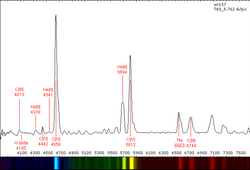| Observation data Epoch J2000 Equinox J2000 | |
|---|---|
| Constellation | Cygnus [2] |
| Right ascension | 20h 14m 31.76669s [3] |
| Declination | +36° 39′ 39.5982″ [3] |
| Apparent magnitude (V) | 7.91 [4] (7.86 - 7.93 [5] ) |
| Characteristics | |
| Evolutionary stage | Wolf-Rayet [6] |
| Spectral type | WC7pd + O9V [7] |
| U−B color index | −0.40 [4] |
| B−V color index | +0.29 [4] |
| Variable type | WR [8] |
| Astrometry | |
| Proper motion (μ) | RA: −2.681 [3] mas/yr Dec.: −5.739 [3] mas/yr |
| Parallax (π) | 0.4898±0.0172 mas [3] |
| Distance | 6,700 ± 200 ly (2,040 ± 70 pc) |
| Absolute magnitude (MV) | −5.7 [9] (−4.18 + −4.34) [7] |
| Orbit [10] | |
| Primary | WR |
| Companion | O |
| Period (P) | 13.105 ± 0.034 yr |
| Semi-major axis (a) | 8.575 ± 0.020 mas |
| Eccentricity (e) | 0.3162 ± 0.0023 |
| Inclination (i) | 97.138 ± 0.063° |
| Longitude of the node (Ω) | 117.934 ± 0.039° |
| Periastron epoch (T) | 2023.857 ± 0.020 |
| Argument of periastron (ω) (primary) | 361.24 ± 0.99° |
| Semi-amplitude (K1) (primary) | 25.6 ± 2.2 km/s |
| Details | |
| WR | |
| Mass | 9.49±3.41 [10] M☉ |
| Radius | 3.8 ± 1 [7] R☉ |
| Luminosity | 398,000 [11] L☉ |
| Temperature | 60,000 ± 5,000 [7] K |
| O | |
| Mass | 17.34±1.91 [10] M☉ |
| Radius | 7.7 ± 1 [7] R☉ |
| Luminosity | 158,000 [11] L☉ |
| Surface gravity (log g) | 4.0 ± 0.3 [7] cgs |
| Temperature | 32,000 ± 2,000 [7] K |
| Rotational velocity (v sin i) | 220 ± 20 [7] km/s |
| Age | 4.1 [11] Myr |
| Other designations | |
| V1679 Cygni, WR 137, HD 192641, HIP 99769, BD+35°4001, Hen 3-1839 | |
| Database references | |
| SIMBAD | data |

WR 137 is a variable Wolf-Rayet star located around 6,000 light years away from Earth in the constellation of Cygnus.
WR 137, together with WR 134 and WR 135, was one of three stars in Cygnus observed in 1867 to have unusual spectra consisting of intense emission lines rather than the more normal continuum and absorption lines. These were the first members of the class of stars that came to be called Wolf-Rayet stars (WR stars) after Charles Wolf and Georges Rayet who discovered their unusual appearance. [12] It is a member of the carbon sequence of WR stars, indicated by the lack of nitrogen lines and the strength of carbon emission. WR 137 has a spectrum with CIII emission weaker than CIV and OV weaker still, leading to the assignment of a WC7 spectral type. The spectrum also shows emission lines of HeII and OIV. [13] [14]

WR 137 is a binary system, with an O9 main sequence or giant companion. The two stars orbit every thirteen years in a mildly eccentric orbit, and there is an episode of dust production near periastron. The inclination of the orbit is high, near 97 degrees. [10] The O star is visually brighter and more massive, but the WR star dominates the spectrum and has a higher bolometric luminosity. Visible in the spectrum are absorption lines and some narrow emission lines, each thought to originate from the secondary star. The line profiles suggest a decretion disc around the star, produced by its rapid rotation, which would make it the only known system containing a WR star and an Oe star. [11]
WR 137 is about a degree away from WR 135 and the two are believed to lie at approximately the same distance from Earth within the Cygnus OB3 association. [15] Its properties are uncertain because of the presence of the hot luminous companion. A pseudo-fit of the combined spectrum yielded a temperature of 56,000 K, a luminosity of 537,000 L☉, and a radius of 10 R☉. A more typical radius for a WC7 star would be 4.5 R☉, implying a hotter temperature. [9]
Evolutionary modelling of the WR 137 pair suggest an initial mass for the primary of 60 M☉ and for the secondary of 30 M☉, with an age of 4.1 million years. The initial orbital period would have been around 1,580 days. Around three M☉ have been transferred from the primary to the secondary. [11]
Observations with JWST instrument MIRI did resolve 10 rings around the binary, representing 131 years of dust ejection. The dust moves with a speed of 1700 km/s, near the terminal velocity. Each ring represents a dust plume, which starts to form near a quadrature in their orbit and continues after the conjunction. This results in dust being seen in both directions along the nearly edge-on orbital plane. [1]
